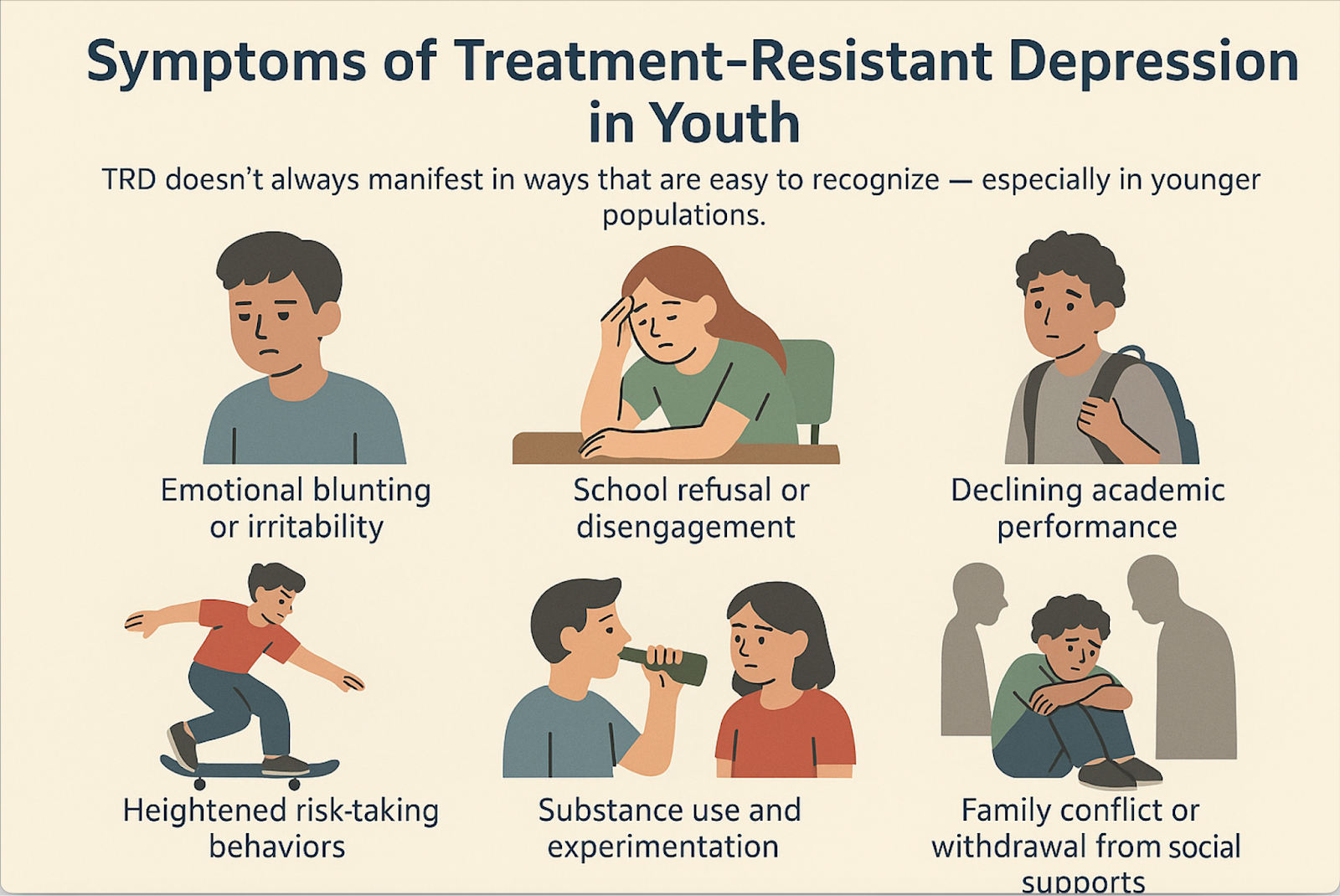Why Are So Many Young Adults Struggling with Treatment-Resistant Depression?
Imagine being a young person who has tried two or more different antidepressants but still feels stuck in the same dark place. This is not just an individual story — it’s becoming an all-too-common experience. Treatment-resistant depression (TRD) is rising, particularly among teens, college students, and young adults navigating the fraught transition to adulthood.
At Lumin Health, we are seeing this pattern with increasing frequency. Understanding why this age group is so vulnerable, why many don’t respond to traditional treatments, and what emerging therapies can offer is essential — not just for clinical care, but for compassion.
The Alarming Rise of Depression in Adolescents and Young Adults
Data from the Centers for Disease Control (CDC’s) recent Youth Risk Behavior Survey paints a stark picture:
The prevalence of mental-health disorders among adolescents has increased significantly over the past decade. Between 2011 to 2021, the number of American high school students reporting persistent sadness or hopelessness with functional impairment increased from 28.5% to 42%1. Alongside this rise, the prevalence of major depressive disorder (MDD) in adolescents aged 12 to 17 hovers around 16%, with an estimated 2.7 million experiencing severe depression annually.
Suicidality, too, has climbed — especially among girls and LGBTQ+ youth, who face unique social and identity-related stressors. Despite this surge, over half of teens with depression receive no mental health treatment at all. For those who do, around one in five find themselves treatment-resistant: they’ve tried two or more antidepressants with little to no relief.
This data is more than numbers; it signals a collective crisis among our youth.
Symptoms of Treatment-Resistant Depression in Youth
TRD doesn’t always manifest in ways that are easy to recognize — especially in younger populations. Beyond classic symptoms of low mood and hopelessness, teens and young adults may show:
- Emotional blunting or irritability
- School refusal or disengagement
- Declining academic performance
- Heightened risk-taking behaviors
- Substance use and experimentation
- Family conflict or withdrawal from social supports

In young adults , TRD can intersect with identity formation, the struggle for autonomy, and the stress of academic pressures — all while their brains are still undergoing critical developmental changes. For this group, depression isn’t just sadness — it’s an arrested capacity to engage with life at a pivotal moment.
Why Are Traditional Treatments Often Ineffective?
Several factors help explain why antidepressants sometimes fail this age group:
- Ongoing Brain Development: The adolescent and young adult brain is still maturing, especially in regions governing emotion regulation and executive function. The underdevelopment of prefrontal regions and heightened reactivity of the brain's fear center can lead to emotional dysregulation that antidepressants aren’t fully equipped to address.
- Social and Environmental Stressors: Social media, bullying, evolving gender and sexual identities, and the demands of college life all create complex stress environments that medications alone may not address.
- Barriers to Quality Care: Access to skilled, age-sensitive mental health care remains patchy. Stigma, cost, and a shortage of adolescent-focused providers contribute to delayed or fragmented treatment.
- Emotional Complexity: For many young people, depression is intertwined with trauma, family dynamics, and identity exploration. Standard pharmacologic treatments often don’t reach these layers.
- Non-Specific Diagnosis: “Depression” in youth may be a surface label for a range of issues—ADHD, autism, substance use, emerging bipolar disorder. Antidepressants may not be appropriate for all of these. Adolescents may also present with "masked" depression—irritability, somatic complaints, or externalizing behavior—which often leads to misdiagnosis and mismatched treatment.
- Medication Adherence: Adolescents may forget, refuse, or inconsistently take medications due to side effects, stigma, or lack of insight, leading to reduced efficacy.
When medications don’t work, it’s not uncommon for young people to feel demoralized — convinced they’re beyond help. This perception can deepen the depressive cycle and reinforce hopelessness.
Ketamine Therapy: An Emerging Option for TRD in Young Adults
At Lumin Health, we are increasingly exploring ketamine therapy as an option for young adults with TRD. Ketamine operates differently than traditional antidepressants: rather than modulating serotonin or norepinephrine, ketamine impacts the brain’s glutamate system. This leads to enhanced neuroplasticity — the brain’s ability to form new connections — which may provide a reset for entrenched depressive circuits.
Unlike typical antidepressants that can take weeks to show benefits, ketamine’s effects can emerge within hours to days. This rapid action is particularly important for individuals grappling with suicidality or profound functional impairment due to their depression. .
Additionally, when coupled with therapy and social support, ketamine can help young adults re-engage with their own narratives — opening space for new perspectives and emotional shifts that medications alone rarely provide.
Of course, ketamine is not a first-line treatment, nor is it a one-size-fits-all solution. Careful screening, comprehensive assessment, and a supportive clinical environment are critical to ensuring safety and effectiveness. For young people navigating complex emotional landscapes, these safeguards are essential.
Looking Forward: A Call for Whole-Person Centered Care at Lumin Health
Understanding the rise in treatment-resistant depression among young people demands a holistic lens. It’s not just about finding the right medication — it’s about addressing the layered biological, psychological, and social factors that shape mental health in adolescence and early adulthood.
For families, providers, and young adults themselves, there is reason for hope. New treatments like ketamine are expanding the landscape of possibility. But even more importantly, compassionate, patient-centered care that respects each individual’s experience remains the cornerstone of effective treatment.
At Lumin Health, we believe that the conversation around TRD in young adults must be as dynamic as the lives we’re striving to support. If you, your child, or a student you care about is struggling with treatment-resistant depression, we welcome the opportunity to explore what options may be right for you.
1. Youth Risk Behavior Survey Data Summary & Trends Report: 2011-2021. Available online at: https://www.cdc.gov/healthyyouth/data/yrbs/yrbs_data_summary_and_trends.htm (Accessed May 15, 2024).





